ZnO Nanocrystal-Based Chloroform Detection: Density Functional Theory (DFT) Study
Abstract
1. Introduction
2. Methods and Computational Details
3. Results and Discussion
3.1. Geometric Optimization
3.2. CHCl3 Interaction with the Zn12O12 Nanocage
3.3. O Atom Interaction with the Zn12O12 Nanocage
3.4. CHCl3 Interaction with O Atoms Deposited on the Zn12O12 Nanocage
3.5. Zn12O12 Nanocage as a Sensor for CHCl3
4. Conclusions
Author Contributions
Funding
Acknowledgments
Conflicts of Interest
References
- Batzill, M.; Diebold, U. The surface and materials science of tin oxide. Prog. Surf. Sci. 2005, 79, 47–154. [Google Scholar] [CrossRef]
- Wang, Z.-H.; Yang, C.-C.; Yu, H.-C.; Peng, Y.-M.; Su, Y.-K. Electron emission enhanced properties of gold nanoparticle-decorated ZnO nanosheets grown at room temperature. Sci. Adv. Mater. 2018, 10, 1675–1679. [Google Scholar] [CrossRef]
- Kim, E.-B.; Lee, J.-E.; Akhtar, M.S.; Ameen, S.; Fijahi, L.; Seo, H.-K.; Shin, H.-S. Electrical sensor based on hollow ZnO spheres for hydrazine detection. J. Nanoelectron. Optoelectron. 2018, 13, 1769–1776. [Google Scholar] [CrossRef]
- Bader, C. The dangers of chloroform, etc., and the nitrite of amyl. Lancet 1875, 105, 644. [Google Scholar] [CrossRef]
- Featherstone, P.J.; Ravindran, H. Townley’s chloroform inhaler. J. Anesth. Hist. 2018, 4, 103–108. [Google Scholar] [CrossRef] [PubMed]
- Verma, P.; Tordik, P.; Nosrat, A. Hazards of improper dispensary: Literature review and report of an accidental chloroform injection. J. Endod. 2018, 44, 1042–1047. [Google Scholar] [CrossRef]
- Selby, R. Chloroform-Its benefits and its dangers. Lancet 1848, 51, 190. [Google Scholar] [CrossRef]
- Zhang, K.; Zhang, H.; Liu, R.; Yang, Z.; Yuan, Y.; Wang, F. Fabrication of aluminum doped zinc oxide thin films with various microstructures for gas sensing application. Sci. Adv. Mater. 2018, 10, 367–372. [Google Scholar] [CrossRef]
- Ahad, I.Z.M.; Harun, S.W.; Gan, S.N.; Phang, S.W. Polyaniline (PAni) optical sensor in chloroform detection. Sens. Actuators B Chem. 2018, 261, 97–105. [Google Scholar] [CrossRef]
- Sheng, K.; Lu, H.; Sun, A.; Wang, Y.; Liu, Y.; Chen, F.; Bian, W.; Li, Y.; Kuang, R.; Sun, D. A naked-eye colorimetric sensor for chloroform. Chin. Chem. Lett. 2019, 30, 895–898. [Google Scholar] [CrossRef]
- Sharma, S.; Nirkhe, C.; Pethkar, S.; Athawale, A.A. Chloroform vapour sensor based on copper/polyaniline nanocomposite. Sens. Actuators B Chem. 2002, 85, 131–136. [Google Scholar] [CrossRef]
- Wang, K.; Li, S.; Jiang, Y.; Hu, M.; Zhai, Q.G. A pillar-layered metal-organic framework as luminescent sensor for selective and reversible response of chloroform. J. Solid State Chem. 2017, 247, 39–42. [Google Scholar] [CrossRef]
- Zhang, K.; Zhang, H.; Sun, S.; Yang, Z.; Yuan, Y.; Wang, F. Enhanced gas sensing properties based on ZnO-decorated nickel oxide thin films for formaldehyde detection. Sci. Adv. Mater. 2018, 10, 373–378. [Google Scholar] [CrossRef]
- Kumar, R.; Al-Dossary, O.; Kumar, G.; Umar, A. Zinc oxide nanostructures for NO2 gas sensor applications: A review. Nano Micro Lett. 2015, 7, 97–120. [Google Scholar] [CrossRef] [PubMed]
- Jia, R.; Xie, P.; Feng, Y.; Chen, Z.; Umar, A.; Wang, Y. Dipole-modified graphene with ultrahigh gas sensibility. Appl. Surf. Sci. 2018, 440, 409–414. [Google Scholar] [CrossRef]
- Zhou, Q.; Xu, L.; Umar, A.; Chen, W.; Kumar, R. Pt nanoparticles decorated SnO2 nanoneedles for efficient CO gas sensing applications. Sens. Actuators B Chem. 2018, 256, 656–664. [Google Scholar] [CrossRef]
- Umar, A.; Alshahrani, A.A.; Algarni, H.; Kumar, R. CuO nanosheets as potential scaffolds for gas sensing applications. Sens. Actuators B Chem. 2017, 250, 24–31. [Google Scholar] [CrossRef]
- Al-Hadeethi, Y.; Umar, A.; Ibrahim, A.A.; Al-Heniti, S.H.; Kumar, R.; Baskoutas, S.; Raffah, B.M. Synthesis, characterization and acetone gas sensing applications of Ag-doped ZnO nanoneedles. Ceram. Int. 2017, 43, 6765–6770. [Google Scholar] [CrossRef]
- Umar, A.; Lee, J.-H.; Kumar, R.; Al-Dossary, O. Synthesis and characterization of CuO nanodisks for high-sensitive and selective ethanol gas sensor applications. J. Nanosci. Nanotechnol. 2017, 17, 1455–1459. [Google Scholar] [CrossRef]
- Al-Hadeethi, Y.; Umar, A.; Al-Heniti, S.H.; Kumar, R.; Kim, S.H.; Zhang, X.; Raffah, B.M. 2D Sn-doped ZnO ultrathin nanosheet networks for enhanced acetone gas sensing application. Ceram. Int. 2017, 43, 2418–2423. [Google Scholar] [CrossRef]
- Nam, G.; Leem, J.Y. A new technique for growing ZnO nanorods over large surface areas using graphene oxide and their application in ultraviolet sensors. Sci. Adv. Mater. 2018, 10, 405–409. [Google Scholar] [CrossRef]
- Zhang, N.; Yu, K.; Li, Q.; Zhu, Z.Q.; Wan, Q.J. Room-temperature high-sensitivity H2S gas sensor based on dendritic ZnO nanostructures with macroscale in appearance. Appl. Phys. 2008, 103, 104305. [Google Scholar] [CrossRef]
- Jimenez, I.; Arbiol, J.; Dezanneau, G.; Cornet, A.; Morante, J.R. Crystalline structure, defects and gas sensor response to NO2 and H2S of tungsten trioxide nanopowders. Sens. Actuators B Chem. 2003, 93, 475–485. [Google Scholar] [CrossRef]
- Chen, Z.; Wang, J.; Umar, A.; Wang, Y.; Li, H.; Zhou, G. Three-dimensional crumpled graphene-based nanosheets with ultrahigh NO2 gas sensibility. ACS Appl. Mater. Interfaces 2017, 9, 11819–11827. [Google Scholar] [CrossRef]
- Umar, A.; Akhtar, M.S.; Al-Assiri, M.S.; Al-Salami, A.E.; Kim, S.H. Composite CdO-ZnO hexagonal nanocones: Efficient materials for photovoltaic and sensing applications. Ceram. Int. 2018, 44, 5017–5024. [Google Scholar] [CrossRef]
- Umar, A. Encyclopedia of Semiconductor Nanotechnology; American Scientific Publishers: Los Angeles, CA, USA, 2017. [Google Scholar]
- Choi, H.J.; Lee, Y.M.; Boo, J.H. Well-aligned ZnO nanorods assisted with close-packed polystyrene monolayer for quartz crystal microbalance. Sci. Adv. Mater. 2018, 10, 610–615. [Google Scholar] [CrossRef]
- Yang, J.; Yi, W.; Zhang, L.; Li, T.; Chao, Z.; Fan, J. Facile fabrication of ZnO nanomaterials and their photocatalytic activity study. Sci. Adv. Mater. 2018, 10, 1721–1728. [Google Scholar] [CrossRef]
- Umar, A.; Hahn, Y.B. Metal Oxide Nanostructures and Their Applications; American Scientific Publishers: Los Angeles, CA, USA, 2010. [Google Scholar]
- Wang, J.X.; Sun, X.W.; Yang, Y.; Huang, H.; Lee, Y.C.; Tan, O.K.; Vayssieres, L. Hydrothermally grown oriented ZnO nanorod arrays for gas sensing applications. Nanotechnology 2006, 17, 4995–4998. [Google Scholar] [CrossRef]
- Paraguay, F.; Miki-Yoshida, M.; Morales, J.; Solis, J.; Estrada, L.W. Influence of Al, In, Cu, Fe and Sn dopants on the response of thin film ZnO gas sensor to ethanol vapour. Thin Solid Films 2000, 373, 137–140. [Google Scholar] [CrossRef]
- Chaudhary, S.; Kaur, Y.; Umar, A.; Chaudhary, G.R. Ionic liquid and surfactant functionalized ZnO nanoadsorbent for recyclable proficient adsorption of toxic dyes from waste water. J. Mol. Liq. 2016, 224, 1294–1304. [Google Scholar] [CrossRef]
- Guo, R.; Cheng, X.; Gao, S.; Zhang, X.; Xu, Y.; Zhao, H.; Huo, L. Highly selective detection of saturated vapors of abused drugs by ZnO nanorod bundles gas sensor. Appl. Surf. Sci. 2019, 485, 266–273. [Google Scholar] [CrossRef]
- Shao, C.; Chang, Y.; Long, Y. High performance of nanostructured ZnO film gas sensor at room temperature. Sens. Actuators B Chem. 2014, 204, 666–672. [Google Scholar] [CrossRef]
- Ghenaatian, H.R.; Baei, M.T.; Hashemian, S. Zn12O12 nano-cage as a promising adsorbent for CS2 capture. Superlattices Microstruct. 2013, 58, 198–204. [Google Scholar] [CrossRef]
- Baei, M.T.; Tabar, M.B.; Hashemian, S. Zn12O12 fullerene-like cage as a potential sensor for SO2 detection. Adsorpt. Sci. Technol. 2013, 3, 469–476. [Google Scholar] [CrossRef]
- Ammar, H.Y. CH2O adsorption on M (M = Li, Mg and Al) atom deposited ZnO nano-cage: DFT study. Key Eng. Mater. 2018, 786, 384. [Google Scholar] [CrossRef]
- Mayya, D.S.; Prasad, P.; Kumar, J.R.N.; Aswanth, P.; Mayur, G.; Aakanksha, M.; Bindushree, N. Nanocrystalline zinc oxide thin film gas sensor for detection of hydrochloric acid, ethanolamine, and chloroform. Int. J. Adv. Res. Sci. Eng. Technol. 2018, 7, 809–818. [Google Scholar]
- Frisch, M.J.; Trucks, G.W.; Schlegel, H.B.; Scuseria, G.E.; Robb, M.A.; Cheeseman, J.R.; Montgomery, J.A., Jr.; Vreven, T.; Kudin, K.N.; Burant, J.C.; et al. Gaussian 09; Gaussian, Inc.: Wallingford, CT, USA, 2004. [Google Scholar]
- Becke, A.D. Density-functional thermochemistry. III. The role of exact exchange. J. Chem. Phys. 1993, 98, 5648. [Google Scholar] [CrossRef]
- Vosko, S.H.; Wilk, L.; Nusair, M. Accurate spin-dependent electron liquid correlation energies for local spin density calculations: A critical analysis. Can. J. Phys. 1980, 58, 1200–1211. [Google Scholar] [CrossRef]
- Becke, A.D. Density-functional exchange-energy approximation with correct asymptotic behavior. Phys. Rev. A 1988, 38, 3098. [Google Scholar] [CrossRef]
- Lee, C.; Yang, W.; Parr, R.G. Development of the Colle-Salvetti correlation-energy formula into a functional of the electron density. Phys. Rev. B 1988, 37, 785. [Google Scholar] [CrossRef]
- Miehlich, B.; Savin, A.; Stoll, H.; Preuss, H. Results obtained with the correlation energy density functionals of becke and Lee, Yang and Parr. Chem. Phys. Lett. 1989, 157, 200–206. [Google Scholar] [CrossRef]
- Beheshtian, J.; Peyghan, A.A.; Bagheri, Z. Adsorption and dissociation of Cl2 molecule on ZnO nanocluster. Appl. Surf. Sci. 2012, 258, 8171. [Google Scholar] [CrossRef]
- Boyle, N.M.O.; Tenderholt, A.L.; Langner, K.M. Cclib: A library for package-independent computational chemistry algorithms. J. Comp. Chem. 2008, 29, 839. [Google Scholar] [CrossRef] [PubMed]
- Glendening, E.D.; Reed, A.E.; Carpenter, J.E.; Weinhold, F. NBO Program, Version 3.1; University of Wisconsin: Madison, WI, USA, 2001. [Google Scholar]
- Narayanaswamy, A.; Xu, H.F.; Pradhan, N.; Peng, X.G. Crystalline nanoflowers with different chemical compositions and physical properties grown by limited ligand protection. Angew. Chem. Int. Ed. 2006, 45, 5361. [Google Scholar] [CrossRef] [PubMed]
- Joshi, P.; Shewale, V.; Pandey, R.; Shanker, V.; Hussain, S.; Karna, S.P. Site specific interaction between ZnO nanoparticles and tryptophan: A first principles quantum mechanical study. Phys. Chem. Chem. Phys. 2011, 13, 476. [Google Scholar] [CrossRef] [PubMed]
- Shalabi, A.S.; Abdel Aal, S.; Kamel, M.A.; Taha, H.O.; Ammar, H.Y.; Abdel Halim, W.S. The role of oxidation states in FA1 Tl n+ (n = 1, 3) lasers and CO interactions at the (1 0 0) surface of NaCl: An ab initio study. Chem. Phys. 2006, 328, 8–16. [Google Scholar] [CrossRef]
- Shalabi, A.S.; Abdel Aal, S.; Ammar, H.Y. Artificial polarization effects on FA1:Sr2+ lasers and NO interactions at NaCl (001) surface: First principles calculations. J. Mol. Struct. Theochem. 2007, 823, 47–58. [Google Scholar] [CrossRef]
- Li, S. Semiconductor Physical Electronics, 2nd ed.; Springer: New York, NY, USA, 2006. [Google Scholar]
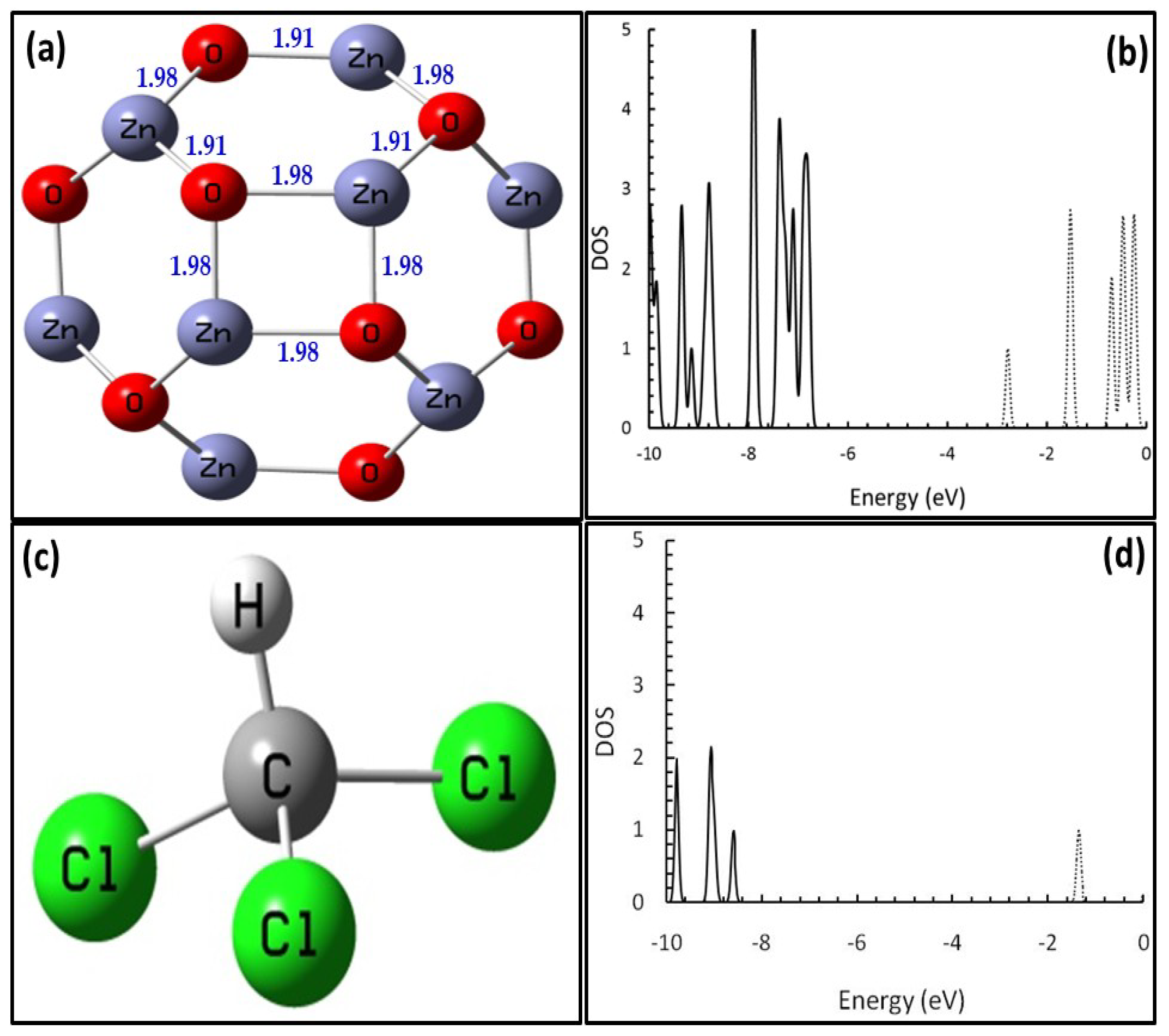
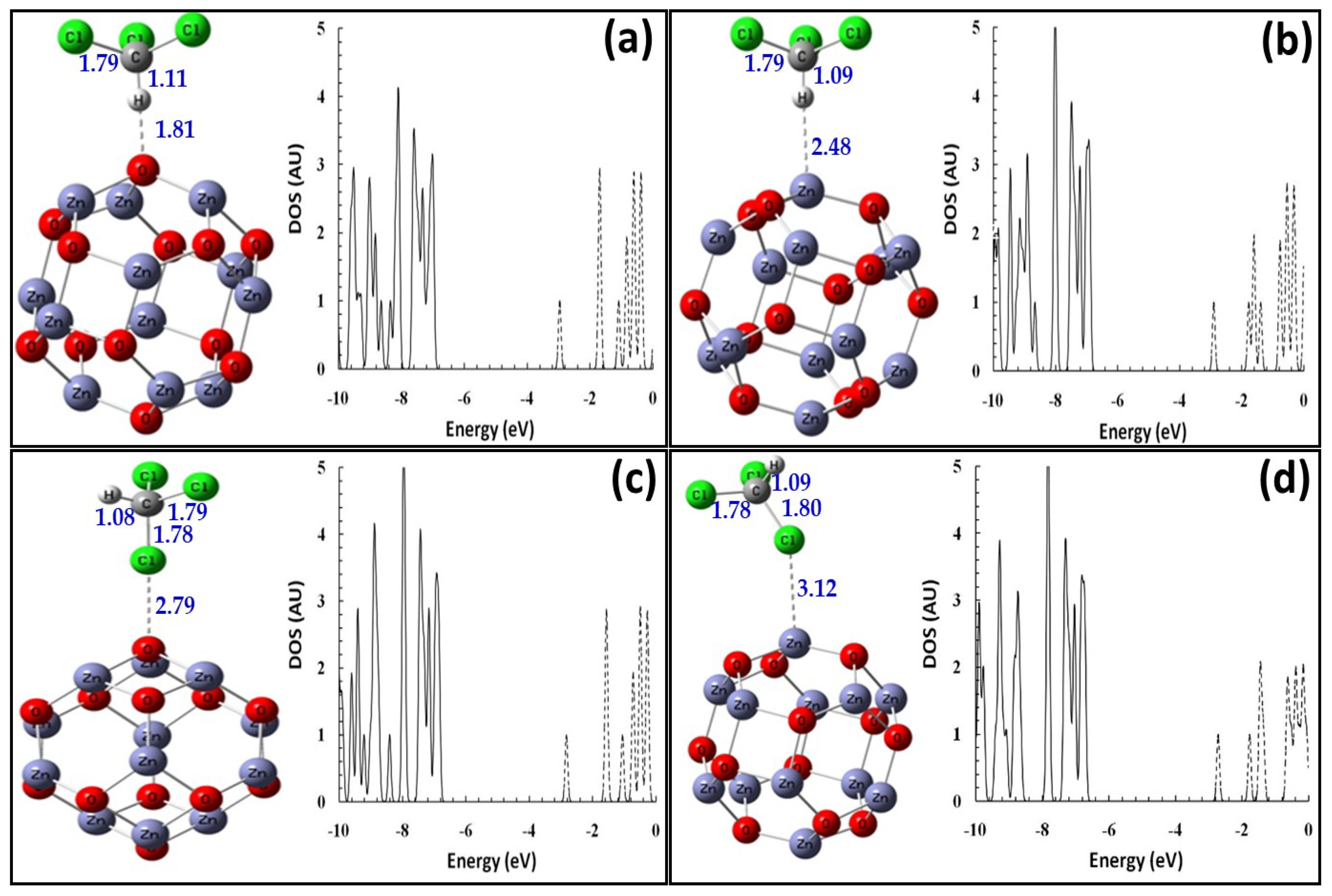
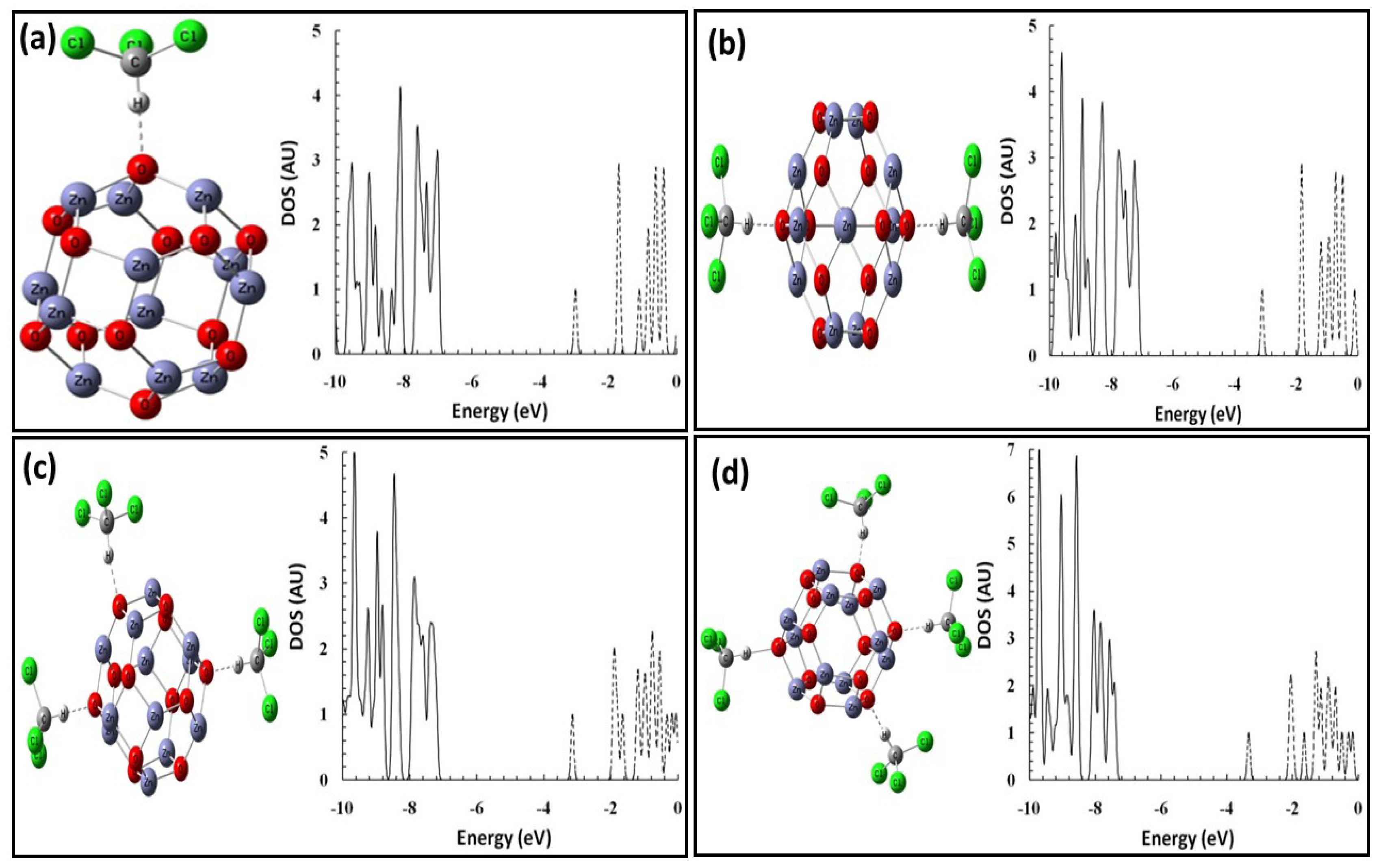
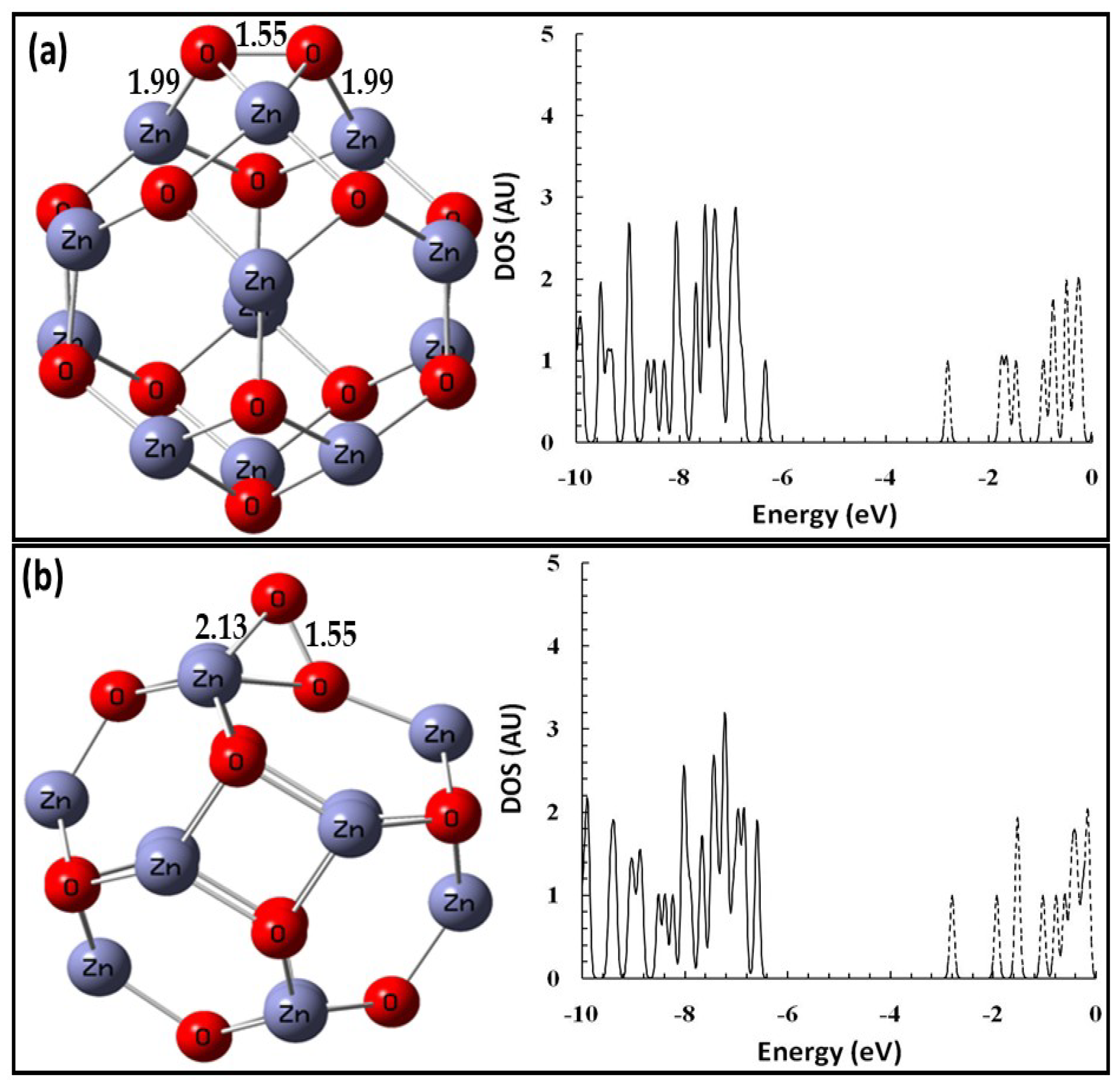

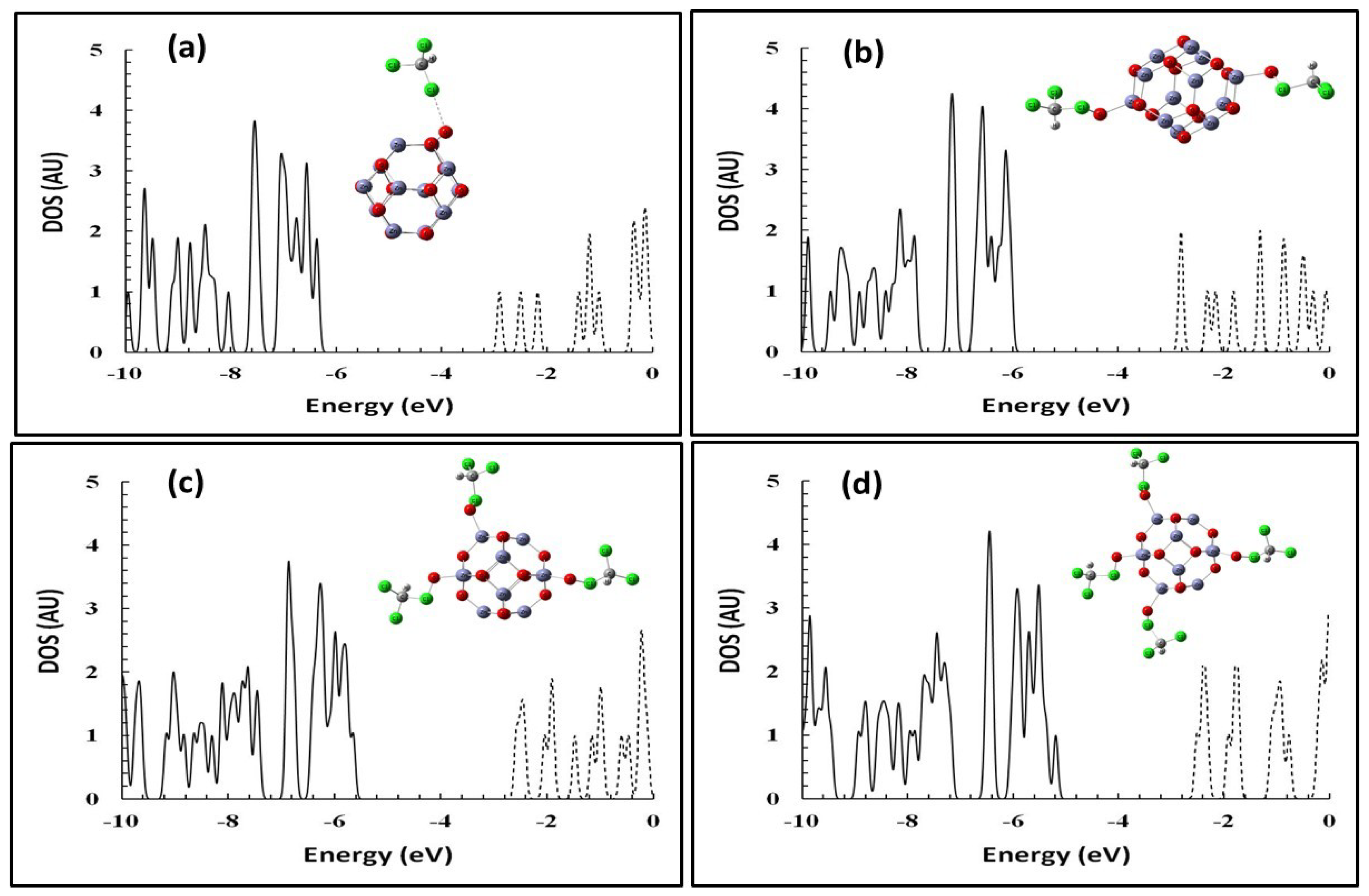
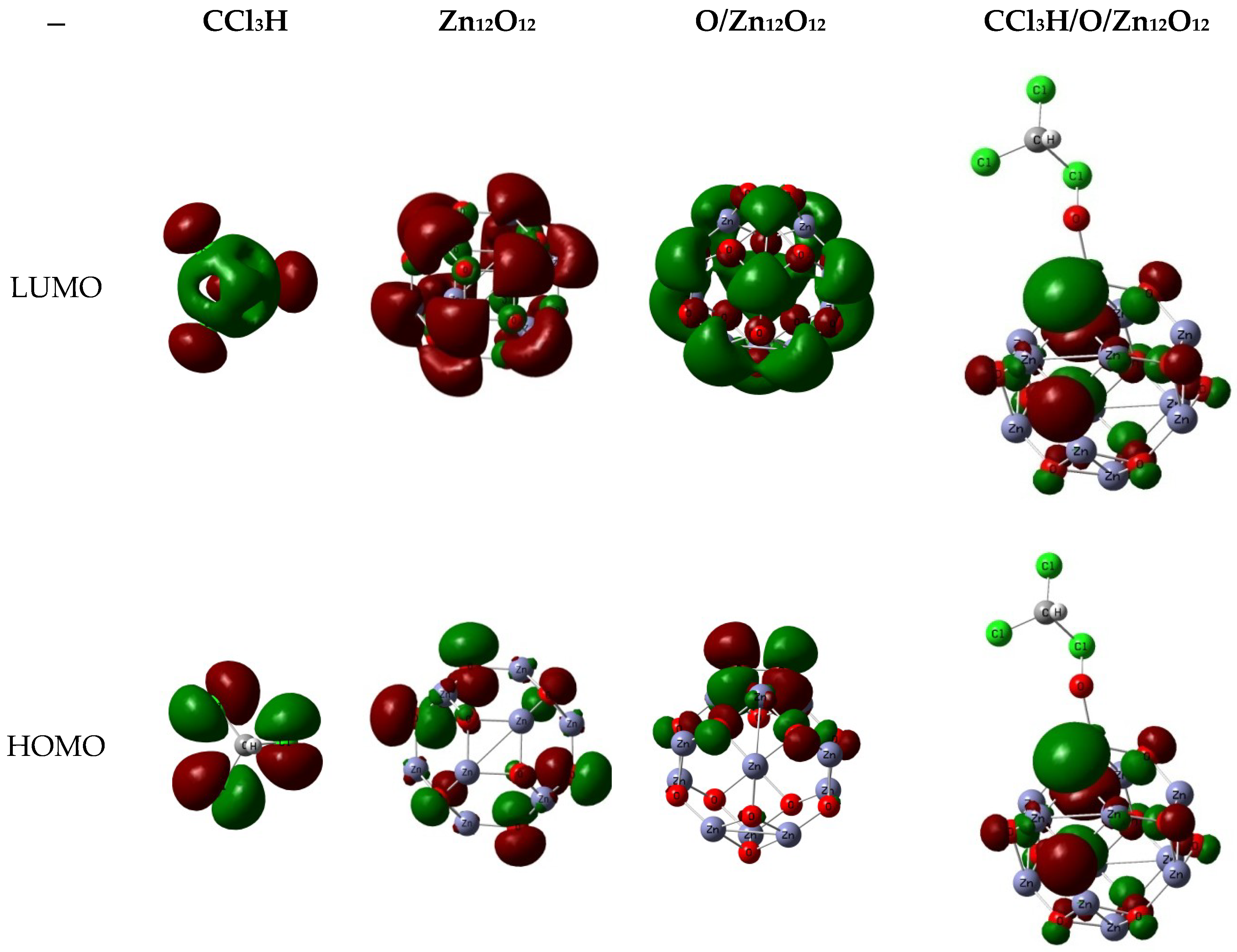
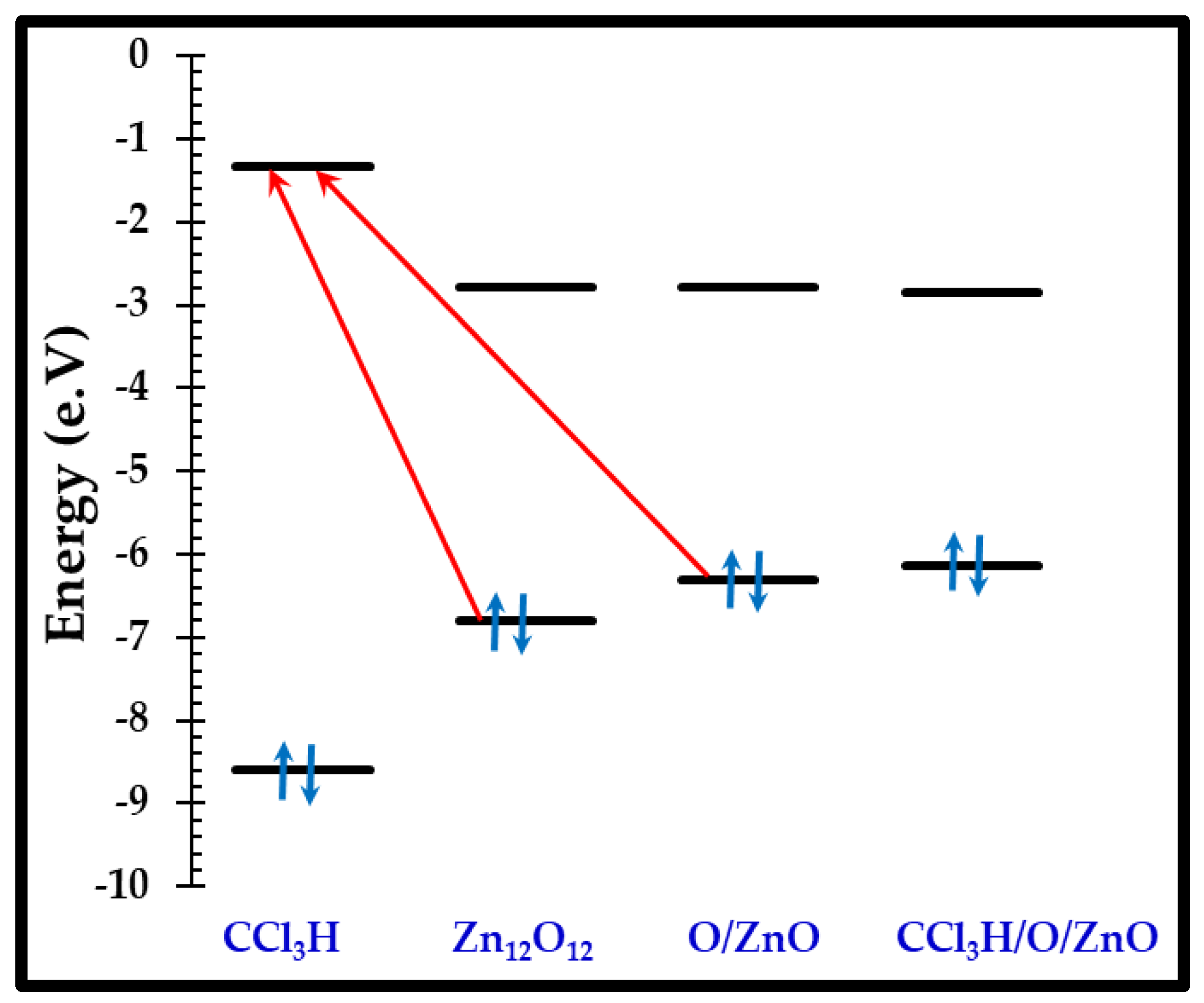
| System | Bare Z12O12 | (a) | (b) | (c) | (d) |
|---|---|---|---|---|---|
| Eads | − | −0.38 | 0.07 | −0.09 | −0.04 |
| EHOMO | −6.81 | −6.98 | −6.90 | −6.84 | −6.71 |
| ELUMO | −2.79 | −2.96 | −2.89 | −2.82 | −2.71 |
| EFL | −4.80 | −4.97 | −4.90 | −4.83 | −4.71 |
| Eg | 4.02 | 4.03 | 4.00 | 4.02 | 4.00 |
| QCHCl3 | − | −0.02 | 0.00 | −0.01 | 0.02 |
| D | 0.00 | 3.05 | 1.41 | 1.33 | 2.17 |
| System | (a) | (b) | (c) | (d) |
|---|---|---|---|---|
| n = 1 | n = 2 | n = 3 | n = 4 | |
| Eads | −0.38 | −0.38 | −0.60 | −0.76 |
| EHOMO | −6.98 | −7.14 | −7.19 | −7.39 |
| ELUMO | −2.96 | −3.10 | −3.14 | −3.32 |
| EFL | −4.97 | −5.12 | −5.16 | −5.36 |
| Eg | 4.03 | 4.04 | 4.05 | 4.07 |
| QCHCl3 | −0.02 | −0.02 | −0.02 | −0.01 |
| D | 3.05 | 0.46 | 1.18 | 1.64 |
| System | O/Zn12O12 | O/Zn12O12 |
|---|---|---|
| (a) | (b) | |
| Eads | −1.98 | −1.62 |
| EHOMO | −6.32 | −6.57 |
| ELUMO | −2.79 | −2.79 |
| EFL | −4.56 | −4.68 |
| Eg | 3.53 | 3.78 |
| QO | −0.71 | −0.61 |
| D | 2.03 | 0.72 |
| System | (a) | (b) | (c) |
|---|---|---|---|
| Eads | −2.44 | −1.98 | −0.92 |
| Eb | −0.68 | −0.15 | −2.46 |
| EHOMO | −6.45 | −6.13 | −6.30 |
| ELUMO | −2.81 | −2.85 | −2.98 |
| EFL | −4.63 | −4.49 | −4.64 |
| Eg | 3.64 | 3.27 | 3.32 |
| QCHCl3 | 0.07 | 0.03 | 0.86 |
| QO | −0.63 | −0.62 | −0.76 |
| QZnO | 0.56 | 0.59 | −0.10 |
| D | 1.92 | 2.35 | 8.26 |
| System | (a) | (b) | (c) | (d) |
|---|---|---|---|---|
| n = 1 | n = 2 | n = 3 | n = 4 | |
| Eads | −0.92 | −0.96 | −0.96 | −0.86 |
| EHOMO | −6.30 | −6.03 | −5.65 | −5.19 |
| ELUMO | −2.98 | −2.81 | −2.57 | −2.51 |
| EFL | −4.64 | −4.42 | −4.11 | −3.85 |
| Eg | 3.32 | 3.22 | 3.08 | 2.68 |
| QCHCl3 | 0.86 | 0.77 | 0.74 | 0.74 |
| QO | −0.76 | −0.61 | −0.59 | −0.58 |
| QZnO | −0.10 | −0.33 | −0.47 | −0.62 |
| D | 8.26 | 3.26 | 4.15 | 6.45 |
© 2019 by the authors. Licensee MDPI, Basel, Switzerland. This article is an open access article distributed under the terms and conditions of the Creative Commons Attribution (CC BY) license (http://creativecommons.org/licenses/by/4.0/).
Share and Cite
Ammar, H.Y.; Badran, H.M.; Umar, A.; Fouad, H.; Alothman, O.Y. ZnO Nanocrystal-Based Chloroform Detection: Density Functional Theory (DFT) Study. Coatings 2019, 9, 769. https://doi.org/10.3390/coatings9110769
Ammar HY, Badran HM, Umar A, Fouad H, Alothman OY. ZnO Nanocrystal-Based Chloroform Detection: Density Functional Theory (DFT) Study. Coatings. 2019; 9(11):769. https://doi.org/10.3390/coatings9110769
Chicago/Turabian StyleAmmar, H. Y., H. M. Badran, Ahmad Umar, H. Fouad, and Othman Y. Alothman. 2019. "ZnO Nanocrystal-Based Chloroform Detection: Density Functional Theory (DFT) Study" Coatings 9, no. 11: 769. https://doi.org/10.3390/coatings9110769
APA StyleAmmar, H. Y., Badran, H. M., Umar, A., Fouad, H., & Alothman, O. Y. (2019). ZnO Nanocrystal-Based Chloroform Detection: Density Functional Theory (DFT) Study. Coatings, 9(11), 769. https://doi.org/10.3390/coatings9110769








